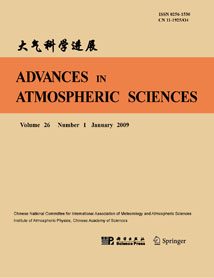| [1] |
WANG Yi, YAN Zhongwei,
2011: Changes of Frequency of Summer Precipitation Extremes over the Yangtze River in Association with Large-scale Oceanic-atmospheric Conditions, ADVANCES IN ATMOSPHERIC SCIENCES, 28, 1118-1128.
doi: 10.1007/s00376-010-0128-7
|
| [2] |
G. B. Pant, K. Rupa Kumar, B. Parthasarathy, H. P. Borgaonkar,
1988: LONG-TERM VARIABILITY OF THE INDIAN SUMMER MON-SOON AND RELATED PARAMETERS, ADVANCES IN ATMOSPHERIC SCIENCES, 5, 469-481.
doi: 10.1007/BF02656792
|
| [3] |
Gong-Wang Si, Kuranoshin Kato, Takao Takeda,
1995: The Early Summer Seasonal Change of Large-scale Circulation over East Asia and Its Relation to Change of The Frontal Features and Frontal Rainfall Environment During 1991 Summer, ADVANCES IN ATMOSPHERIC SCIENCES, 12, 151-176.
doi: 10.1007/BF02656829
|
| [4] |
Jing YANG, Sicheng HE, Qing BAO,
2021: Convective/Large-scale Rainfall Partitions of Tropical Heavy Precipitation in CMIP6 Atmospheric Models, ADVANCES IN ATMOSPHERIC SCIENCES, 38, 1020-1027.
doi: 10.1007/s00376-021-0238-4
|
| [5] |
Wang Huijun, Xue Feng, Zhou Guangqing,
2002: The Spring Monsoon in South China and Its Relationship to Large-Scale Circulation Features, ADVANCES IN ATMOSPHERIC SCIENCES, 19, 651-664.
doi: 10.1007/s00376-002-0005-0
|
| [6] |
HE Jinhai, SUN Chenghu, LIU Yunyun, Jun MATSUMOTO, LI Weijing,
2007: Seasonal Transition Features of Large-Scale Moisture Transport in the Asian-Australian Monsoon Region, ADVANCES IN ATMOSPHERIC SCIENCES, 24, 1-14.
doi: 10.1007/s00376-007-0001-5
|
| [7] |
Chao Jiping, Ji Zhengang,
1985: ON THE INFLUENCES OF LARGE-SCALE INHOMOGENEITY OF SEA TEMPERATURE UPON THE OCEANIC WAVES IN THE TROPICAL REGIONS——PART I : LINEAR THEORETICAL ANALYSIS, ADVANCES IN ATMOSPHERIC SCIENCES, 2, 295-306.
doi: 10.1007/BF02677245
|
| [8] |
Ji Zhengang, Chao Jiping,
1986: ON THE INFLUENCES OF LARGE-SCALE INHOMOGENEITY OF SEA TEMPERATURE UPON THE OCEANIC WAVES IN THE TROPICAL REGIONS PART II: LINEAR NUMERICAL EXPERIMENTS, ADVANCES IN ATMOSPHERIC SCIENCES, 3, 238-244.
doi: 10.1007/BF02682557
|
| [9] |
S. V. Singh, C.M. Mohile, S. R. Inamdar,
1987: RELATIONSHIPS OF SOUTHERN-OSCILLATION AND OTHER LARGE-SCALE FEATURES WITH BAY OF BENGAL CYCLONES DURING THE POST-MONSOON SEASON, ADVANCES IN ATMOSPHERIC SCIENCES, 4, 169-174.
doi: 10.1007/BF02677063
|
| [10] |
SU Qin, LU Riyu, LI Chaofan,
2014: Large-scale Circulation Anomalies Associated with Interannual Variation in Monthly Rainfall over South China from May to August, ADVANCES IN ATMOSPHERIC SCIENCES, 31, 273-282.
doi: 10.1007/s00376-013-3051-x
|
| [11] |
R. H. Kripalani, S. V. Singh,
1993: Large Scale Aspects of India-China Summer Monsoon Rainfall, ADVANCES IN ATMOSPHERIC SCIENCES, 10, 71-84.
doi: 10.1007/BF02656955
|
| [12] |
Ding Yihui, Hu Jian,
1988: THE VARIATION OF THE HEAT SOURCES IN EAST CHINA IN THE EARLY SUMMER OF 1984 AND THEIR EFFECTS ON THE LARGE-SCALE CIRCULATION IN EAST ASIA, ADVANCES IN ATMOSPHERIC SCIENCES, 5, 171-180.
doi: 10.1007/BF02656779
|
| [13] |
LI Xiaofan, SHEN Xinyong, LIU Jia,
2014: Effects of Doubled Carbon Dioxide on Rainfall Responses to Large-Scale Forcing: A Two-Dimensional Cloud-Resolving Modeling Study, ADVANCES IN ATMOSPHERIC SCIENCES, 31, 525-531.
doi: 10.1007/s00376-013-3030-2
|
| [14] |
Kelvin S. NG, Gregor C. LECKEBUSCH, Kevin I. HODGES,
2022: A Causality-guided Statistical Approach for Modeling Extreme Mei-yu Rainfall Based on Known Large-scale Modes—A Pilot Study, ADVANCES IN ATMOSPHERIC SCIENCES, 39, 1925-1940.
doi: 10.1007/s00376-022-1348-3
|
| [15] |
Eric P. CHASSIGNET, Xiaobiao XU,
2021: On the Importance of High-Resolution in Large-Scale Ocean Models, ADVANCES IN ATMOSPHERIC SCIENCES, 38, 1621-1634.
doi: 10.1007/s00376-021-0385-7
|
| [16] |
Gao Shouting,
1988: NONLINEAR ROSSBY WAVE INDUCED BY LARGE-SCALE TOPOGRAPHY, ADVANCES IN ATMOSPHERIC SCIENCES, 5, 301-310.
doi: 10.1007/BF02656754
|
| [17] |
PU Shuzhen, ZHAO Jinping, YU Weidong, ZHAO Yongping, YANG Bo,
2004: Progress of Large-Scale Air-Sea Interaction Studies in China, ADVANCES IN ATMOSPHERIC SCIENCES, 21, 383-398.
doi: 10.1007/BF02915566
|
| [18] |
Huw C. DAVIES,
2006: Large-Scale Weather Systems: A Future Research Priority, ADVANCES IN ATMOSPHERIC SCIENCES, 23, 832-841.
doi: 10.1007/s00376-006-0832-5
|
| [19] |
Xia Daqing, Zheng Liangjie,
1986: NUMERICAL SIMULATION OF THE GENERATION OF MESOSCALE CONVECTTVE SYSTEMS IN LARGE-SCALE ENVIRONMENT, ADVANCES IN ATMOSPHERIC SCIENCES, 3, 360-370.
doi: 10.1007/BF02678656
|
| [20] |
Guoqing Li, Robin Kung, Richard L. Pfeffer,
1992: A Fluid Experiment of Large-Scale Topography Effect on Baroclinic Wave Flows, ADVANCES IN ATMOSPHERIC SCIENCES, 9, 17-28.
doi: 10.1007/BF02656926
|















 AAS Website
AAS Website 
 AAS WeChat
AAS WeChat 
 DownLoad:
DownLoad: